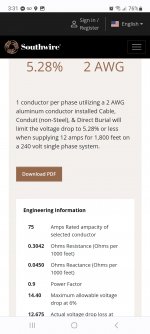AC\DC
Senior Member
- Location
- Florence,Oregon,Lane
- Occupation
- EC
Client has a very old system it’s goes under state road through another owners property.
Pump is 600 yards from well house.
I did not know how far it was when I put a 2-pole gfci in. But the reason I did it was because it was a two wire pump with no ground .
The gfci held for about a year .
The gfci I put in is finnaly tripping so pump or line is broken, or gfci is getting more sensitive either way it has to be fixed.
They’re going to bore that far but a 2hp motor at 240 volt draws 12 amp.
With a 3% vd I am looking at 4/0
If I boost it to 480 with Tran and back down still looking at 1/0
( aluminum for both)
Poco is not an option to get down there..
Have not felt with boring before.
Seems I use there conduits and I don’t supply any. I just size it for them.
Getting a transformer to boost it up seemed good at first but the wire size does not go down that much plus paying for waisted heat.
Any ideas would be appreciated
Pump is 600 yards from well house.
I did not know how far it was when I put a 2-pole gfci in. But the reason I did it was because it was a two wire pump with no ground .
The gfci held for about a year .
The gfci I put in is finnaly tripping so pump or line is broken, or gfci is getting more sensitive either way it has to be fixed.
They’re going to bore that far but a 2hp motor at 240 volt draws 12 amp.
With a 3% vd I am looking at 4/0
If I boost it to 480 with Tran and back down still looking at 1/0
( aluminum for both)
Poco is not an option to get down there..
Have not felt with boring before.
Seems I use there conduits and I don’t supply any. I just size it for them.
Getting a transformer to boost it up seemed good at first but the wire size does not go down that much plus paying for waisted heat.
Any ideas would be appreciated



